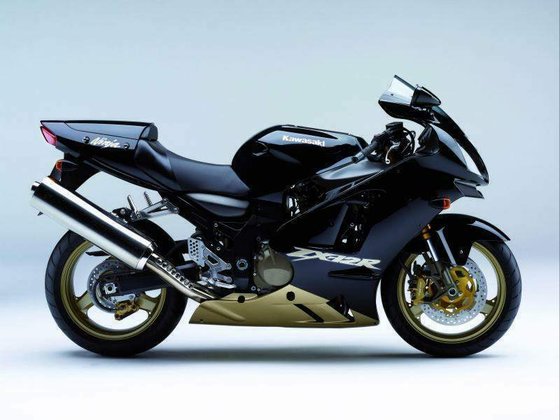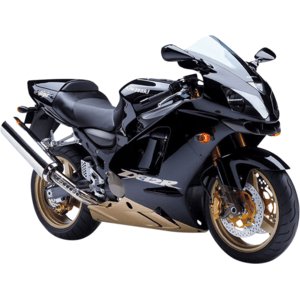Kawasaki ZX-12R Ninja [2002-2003]: A Timeless Speed Legend Revisited

Introduction
When Kawasaki unleashed the ZX-12R Ninja in 2002, it wasn’t just launching another sportbike—it was firing a salvo in the hyperbike wars. Designed to reclaim Kawasaki’s crown in the battle for supremacy against rivals like Suzuki’s Hayabusa and Honda’s Blackbird, the ZX-12R arrived with a mission: to dominate both straight-line speed and technical precision. Riding this machine today, even two decades after its debut, feels like straddling a piece of motorcycle history that still thrills with its raw, unapologetic character. Let’s dive into what makes this early-2000s icon a legend worth revisiting.
Design & Aerodynamics: Form Follows Fury

The ZX-12R’s design is a masterclass in function-first aggression. Its sharp, angular bodywork isn’t just for show—every curve serves a purpose. The signature "snout" houses a Twin Ram Air intake system, which Kawasaki claims boosts airflow by 30% compared to earlier designs. At triple-digit speeds, this isn’t just theoretical; you can feel the engine breathing harder, as if the bike is gulping down the horizon.
Small details like the canard wings on the lower fairing and cast spoilers on the forks aren’t cosmetic quirks. They’re aerodynamic aids that stabilize the bike at speeds exceeding 300 km/h (186 mph). Even the mirrors, mounted low and shaped like arrowheads, slice through turbulence. The monocoque aluminum frame—a first for production bikes—eliminates traditional side spars, narrowing the bike’s profile to aid rider ergonomics and reduce drag.
Despite its bulk (a wet weight of 245 kg / 540 lbs), the ZX-12R hides its mass well. The fuel tank sits under the seat, lowering the center of gravity, while the aggressive stance—24-degree rake and 107 mm (4.2 in) trail—hints at its cornering potential.
Engine & Performance: The Heart of a Predator

The ZX-12R’s 1,199cc inline-four is a masterpiece of controlled chaos. With 178 HP (131 kW) at 10,500 RPM and 134 Nm (98.8 lb-ft) of torque peaking at 7,500 RPM, this engine doesn’t just accelerate—it detonates. Throttle response is immediate, thanks to the 46mm throttle bodies and Nippondenso fuel injection. From idle, the motor growls with intent, but it’s between 6,000 RPM and the 11,000 RPM redline where the ZX-12R truly awakens. The power surge is relentless, pinning you to the seat as the digital tachometer races toward five figures.
Kawasaki’s engineers prioritized mid-range usability for 2002, adding weight to the crankshaft and refining ignition mapping. The result? A bike that’s surprisingly manageable in city traffic yet apocalyptic on open roads. The 6-speed transmission shifts with rifle-bolt precision, though the cable-operated clutch requires a firm hand during aggressive launches.
Standout features like the titanium muffler and chrome-composite plated cylinders (eliminating heavy liners) keep weight in check. Even the oil system is race-inspired, with passages drilled into the clutch hub to improve lubrication during hard riding.
Handling & Dynamics: Taming the Beast

Don’t let the ZX-12R’s dragstrip credentials fool you—this bike corners like it’s on rails. The monocoque frame provides exceptional rigidity, translating rider input into instant direction changes. Paired with a fully adjustable 43mm inverted fork (120 mm / 4.7 in of travel) and a UNI-TRAK® rear shock (123 mm / 4.8 in travel), the setup balances stability and feedback. Dialing in compression and rebound damping is intuitive, making it easy to tailor the bike for canyon carving or high-speed stability.
Braking is equally confidence-inspiring. Dual 320mm discs up front, clamped by 6-piston calipers, deliver monstrous stopping power. The initial bite is firm but progressive, avoiding the wooden feel of older sportbike systems. Out back, a 230mm disc with a 2-piston caliper handles lighter duties without overwhelming traction.
The 200/50-ZR17 rear tire, mounted on a 6-inch rim, provides a massive contact patch. Combined with the bike’s 57.1-inch wheelbase, it inspires mid-corner confidence, even when leaned over at ludicrous angles.
Comfort & Ergonomics: Touring in a Tracksuit
For a hyperbike, the ZX-12R is surprisingly livable. The 820 mm (32.3 in) seat height accommodates most riders, while the slightly raised clip-ons and rearset pegs strike a balance between sportiness and comfort. The seat itself is plush by sportbike standards, though multi-hour rides will still have you craving a break.
Wind protection from the bubble-shaped screen is excellent, diverting airflow over the rider’s helmet at speed. The 19-liter (5.0-gallon) fuel tank offers a realistic range of 250-280 km (155-174 miles), assuming you’re not constantly tapping into the upper third of the rev range.
Competition: How the ZX-12R Stacks Up
In the early 2000s, the ZX-12R faced fierce rivals:
- Suzuki Hayabusa (1999-2007): The Hayabusa’s 1,299cc engine and sleeker aerodynamics gave it a slight edge in top speed (318 km/h vs. 303 km/h). However, the ZX-12R counters with sharper handling and a more engaging ride.
- Honda CBR1100XX Blackbird (1996-2007): Honda’s offering prioritized touring comfort, but its 153 HP engine felt tame next to Kawasaki’s brute.
- Yamaha YZF-R1 (1998-2003): More track-focused, the R1 was lighter and nimbler but lacked the ZX-12R’s straight-line dominance.
Where the ZX-12R shines is its duality. It’s a hyperbike that doesn’t punish you for daily riding, blending Hayabusa-like power with R1-level agility.
Maintenance: Keeping the Legend Alive
Owning a ZX-12R requires diligence, but it’s far from fragile. Key considerations:
- Valve Adjustments: Check every 42,000 km (26,000 miles). Intake valves: 0.15–0.24 mm (0.006–0.009 in), exhaust: 0.22–0.31 mm (0.009–0.012 in).
- Oil Changes: Use 10W-40 synthetic (2.8L with filter). Frequent changes (every 5,000 km / 3,100 miles) are critical for high-revving engines.
- Cooling System: The liquid-cooled design is robust, but monitor coolant levels (3.6L capacity) and replace every 2 years.
- Chain & Sprockets: The 116-link chain demands regular lubrication. Swap worn sprockets (18T front/46T rear) to maintain acceleration.
- Brakes: DOT 4 fluid flushes every 2 years prevent moisture buildup. Replace pads before they compromise the dual front discs.
At MOTOPARTS.store, we stock everything from OEM-spec NGK CR9EKPA spark plugs to performance brake pads, ensuring your ZX-12R remains a force of nature.
Final Thoughts
The Kawasaki ZX-12R Ninja isn’t just a relic of the hyperbike era—it’s a testament to engineering audacity. Its combination of apocalyptic power, razor-sharp handling, and surprising practicality makes it a timeless machine. Whether you’re hunting for vintage charm or a platform to build a modern-day sleeper, the ZX-12R delivers. And when it’s time to upgrade or maintain your beast, MOTOPARTS.store has the expertise and parts to keep your Ninja breathing fire.
Specifications sheet
| Engine | |
|---|---|
| Stroke: | Four-stroke |
| Max power: | 131 kW | 176.0 hp |
| Engine oil: | 10W40 |
| Max torque: | 134 Nm |
| Fuel system: | Electronic fuel injection (46mm throttle bodies) |
| Max power @: | 10500 rpm |
| Displacement: | 1199 ccm |
| Max torque @: | 7500 rpm |
| Configuration: | Inline |
| Cooling system: | Liquid |
| Compression ratio: | 12.2:1 |
| Engine oil capacity: | 2.8 |
| Number of cylinders: | 4 |
| Valves per cylinder: | 4 |
| Dimensions | |
|---|---|
| Wheelbase: | 1450 mm (57.1 in) |
| Dry weight: | 210 |
| Wet weight: | 245 |
| Seat height: | 820 mm (32.3 in) |
| Overall width: | 739 mm (29.1 in) |
| Overall height: | 1199 mm (47.2 in) |
| Overall length: | 2120 mm (82.1 in) |
| Ground clearance: | 119 mm (4.7 in) |
| Fuel tank capacity: | 20 L (5.3 US gal) |
| Drivetrain | |
|---|---|
| Clutch: | Wet, multiple discs, cable-operated |
| Final drive: | chain |
| Chain length: | 116 |
| Transmission: | 6-speed |
| Rear sprocket: | 46 |
| Front sprocket: | 18 |
| Maintenance | |
|---|---|
| Brake fluid: | DOT 4 |
| Spark plugs: | NGK CR9EKPA or NGK CR9EIX |
| Spark plug gap: | 0.7 |
| Coolant capacity: | 3.6 |
| Forks oil capacity: | 1.2 |
| Engine oil change interval: | Every 5000 km or 2 years |
| Valve clearance (intake, cold): | 0.15–0.24 mm |
| Valve clearance check interval: | 24,000 km (15,000 mi) |
| Valve clearance (exhaust, cold): | 0.22–0.31 mm |
| Recommended tire pressure (rear): | 2.9 bar (42 psi) |
| Recommended tire pressure (front): | 2.9 bar (42 psi) |
| Chassis and Suspension | |
|---|---|
| Rake: | 24° |
| Frame: | Aluminum monocoque |
| Trail: | 107 mm (4.2 in) |
| Rear tire: | 200/50 z-17 |
| Front tire: | 120/70 z-17 |
| Rear brakes: | Single 230 mm disc, 2-piston caliper |
| Front brakes: | Dual 320 mm discs, 6-piston calipers |
| Rear suspension: | Bottom-Link monoshock with piggy-back reservoir, adjustable preload, 18-way rebound and 20-way compression damping |
| Front suspension: | 43mm inverted cartridge fork, adjustable preload, 12-way rebound and compression damping |
| Rear wheel travel: | 123 mm (4.8 in) |
| Front wheel travel: | 120 mm (4.7 in) |



















